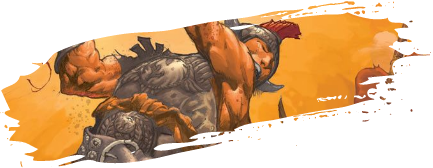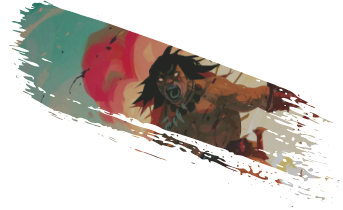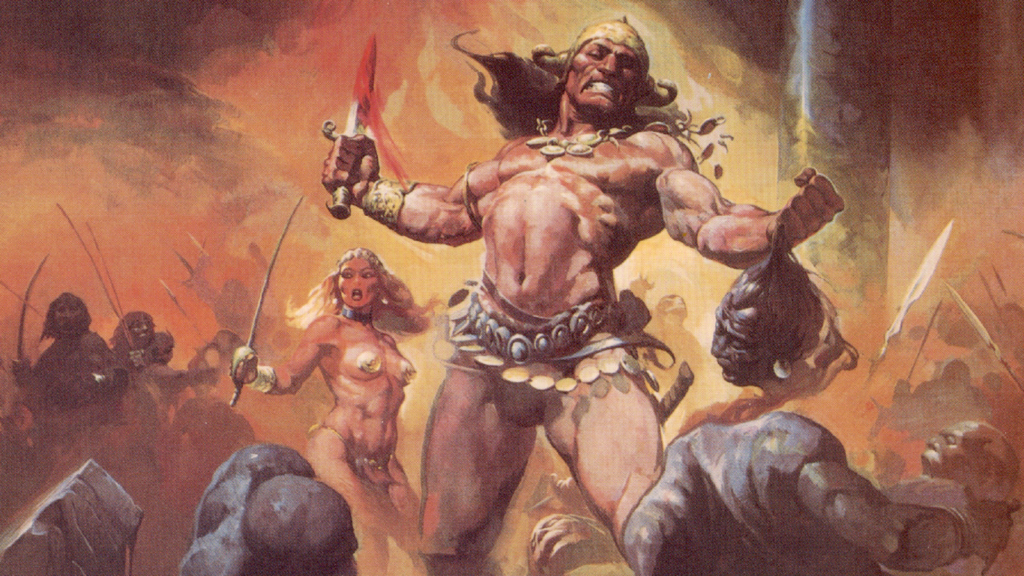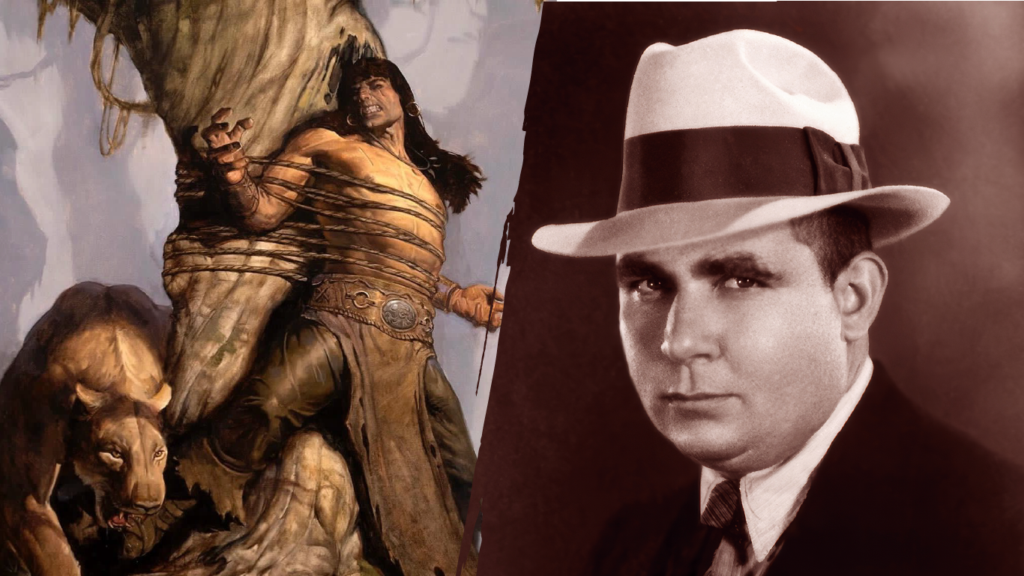
In the harsh wilderness of the Hyborian Age, a lone figure emerges, bound tightly to the gnarled branches of the Tree of Woe.
This striking image of Conan the Barbarian, crucified yet exhausted, captures a moment of intense physical and existential trial. What does this grim tableau reveal about the nature of heroism and the human spirit? Framed by the desolate landscape, Conan’s ordeal is itself a profound meditation on resilience and destiny.
As we explore the iconic Tree of Woe scene from John Milius’s 1982 film, we find layers of meaning that resonate beyond the screen, echoing through the canyons of myth and philosophy.
Join us as we uncover the symbolic and narrative depths of this legendary cinematic moment, where every pang of agony and flash of defiance illuminates the contours of Conan’s epic saga.
From Howard to Hunks on Screen
In Robert E. Howard’s original Conan story, “A Witch Shall Be Born,” the crucifixion scene serves as a pivotal moment that showcases the barbarian’s indomitable will and unwavering resolve. Though the story does not feature the iconic Tree of Woe, it is this harrowing ordeal that inspired John Milius to create the memorable set piece for his 1982 film adaptation.
In Howard’s tale, Conan is crucified in the desert, left to perish under the scorching sun. However, even in the face of certain death, the Cimmerian’s unyielding spirit prevails. Rescued by a band of outlaws, Conan seizes control of the group and leads them on a mission of revenge, ultimately saving the day and triumphing over those who sought to destroy him.
It is this raw display of resilience and determination that Milius sought to capture in his cinematic version of the crucifixion scene. Drawing from Howard’s prose and the evocative imagery of Conan’s ordeal in the comics, the director crafted the Tree of Woe as a powerful visual symbol. By transplanting the crucifixion from the desert to the gnarled branches of a dead tree, Milius imbued the scene with a heightened sense of mythic significance, transforming it into a defining moment in Conan’s character development.

Milius’ cinematic interpretation of this symbol in Conan the Barbarian (1982) elevates the Tree of Woe to even greater heights, positioning it at the climax of the second act, a point where all seems lost and Conan’s journey teeters on the brink of defeat. In this pivotal scene, the barbarian literally returns from the dead, his resurrection a powerful symbol of his unbreakable spirit. The inclusion of Akiro, the wizard portrayed by Mako, further emphasizes the mystical and transformative nature of Conan’s ordeal, as he is guided back from the underworld to continue his quest.
The deeper symbolism of the Tree of Woe resonates with the larger themes that permeate Howard’s Conan stories. It embodies the central tenet of Conan’s character: an unwavering refusal to surrender, even in the face of certain death. This theme echoes throughout Howard’s works, from the gritty determination of his boxing tales to the unyielding resolve of his hero-kings and world travelers. In Conan, this unbeatable spirit finds its purest and most iconic expression, and nowhere is it more powerfully conveyed than at the Tree of Woe.
As Conan’s crucifixion unfolds against the backdrop of a bleak and unforgiving landscape, the scene takes on a mythic quality, evoking images of sacrifice, rebirth, and the triumph of the human spirit. The stark imagery and the barbarian’s grim determination combine to create a moment that is at once visceral and deeply symbolic, a turning point in Conan’s journey that defines his character and sets the stage for his ultimate triumph. It is through this lens that we can begin to understand how Milius and his team approached the daunting task of bringing this iconic scene to life on the silver screen.
Bringing the Iconic Tree of Woe Scene to Life
For Milius and his team, the challenge of adapting the crucifixion into the idea of the Tree of Woe for the big screen was a matter of capturing the raw emotion and philosophical depth that underpinned Conan’s ordeal. The filmmakers drew inspiration from the vivid imagery that had already begun to shape the public’s perception of Conan, particularly the striking visuals of a crucified barbarian that graced the covers of Savage Sword of Conan comics and other artwork.
These pre-existing depictions served as a touchstone for Milius, who sought to bring a heightened sense of realism and intensity to the scene. The stark beauty of the Spanish countryside near Almería provided a fitting backdrop, its rugged terrain and unforgiving landscape mirroring the harsh trials that Conan endured. The physical construction of the Tree of Woe itself was a testament to the filmmakers’ commitment to authenticity, with its plaster-and-Styrofoam exterior built upon a sturdy metal-and-wood skeleton.
Milius’ vision for the scene extended beyond mere spectacle, however. For the director, the Tree of Woe represented a crucial moment in his exploration of the philosophy underlying the film. By subjecting Conan to the ultimate test of his will and forcing him to confront the apparent absence of his god, Crom, Milius sought to strip away the external trappings of the barbarian’s strength and reveal the true source of his power: his unbreakable spirit and unyielding will.
In this sense, the Tree of Woe becomes a metaphor for the tribulations of self-overcoming, a trial by fire that burns away the dross of Conan’s doubts and fears, leaving only the pure, unyielding essence of his being. Schwarzenegger’s portrayal of Conan in this scene is a nod to the actor’s dedication to embodying the character’s inner strength, his face a mask of grim determination as he battles not only the physical agony of the crucifixion, but the existential crisis that threatens to consume him.

Through meticulous attention to detail and a keen understanding of the scene’s philosophical underpinnings, Milius and his team craft a moment that is at once visceral and deeply resonant. The inclusion of the vulture, a living embodiment of death and decay, serves as a powerful symbol of the forces that seek to destroy Conan, both from without and within.
As the scene builds to its climax, with Conan’s friends arriving to rescue him from the brink of death, the filmmakers imbue the moment with a sense of mythic grandeur, the barbarian’s resurrection an illustration to the triumph of the human will over even the darkest of fates. It is in this moment that Conan truly embodies the Nietzschean ideal of the übermensch, his spirit forged anew in the flames of suffering and self-overcoming. It is against this backdrop of existential transformation that Conan’s character takes on new depth and significance, setting the stage for his final confrontation with Thulsa Doom and the forces that seek to enslave the human spirit.
Conan & Nietzsche
As the Tree of Woe scene etches itself into the annals of cinematic history, its philosophical underpinnings have not escaped scrutiny. The film’s Nietzschean themes, particularly the concept of the übermensch, have drawn both praise and criticism, with some commentators expressing concern over perceived connections to fascist ideology.
It is here that we must pause to disentangle the complex web of ideas that have become entangled in the public imagination. While it is true that Nietzsche’s philosophy was misappropriated and perverted by the Nazis in the years following his death, this distortion was the result of a deliberate campaign of misinformation and selective editing, orchestrated by the philosopher’s sister, Elisabeth Förster-Nietzsche, a committed anti-Semite and German nationalist.
In truth, Nietzsche himself was a vocal critic of anti-Semitism and nationalism, and his writings were intended as a warning against the dangers of blind obedience to authority and the abandonment of personal responsibility. The übermensch, as conceived by Nietzsche, was not a genetically superior being destined to rule over others, but rather an individual who had overcome the limitations of societal norms and embraced the power of self-creation and self-mastery.
It is through this lens that we must view Conan’s journey in the 1982 film, and particularly his ordeal on the Tree of Woe. Far from embodying fascist notions of genetic superiority, Conan’s greatness stems from his indomitable will and the transformative power of his experiences. His suffering on the tree is not just a physical trial, but an existential baptism of fire that strips away the illusions of the world and forces him to confront the essential nature of his being.
In this sense, some viewers of the film have interpreted Conan’s triumph over the Tree of Woe as a powerful refutation of the fascist worldview. It is not his birthright or his genetic heritage that defines him, but rather his ability to forge his own destiny through sheer force of will. His struggle is not one of domination over others, but of self-mastery and self-overcoming, a deeply personal journey that resonates with the fundamental human yearning for meaning and purpose.
The Tree of Woe scene, in particular, has become a touchstone for fans of the sword and sorcery genre, its raw emotional power and mythic symbolism serving as a template for countless tales of heroic struggle and personal transformation. Its influence can be felt in the pages of countless comics, novels, and short stories, as well as on the silver screen and in the realm of video games.
In many ways, the Tree of Woe scene interestingly pushes the boundaries of the sword and sorcery film genre. Its legacy, like that of Conan himself, is one of both triumph and tragedy, a testament to the enduring power of myth and the eternal struggle of the human spirit to find meaning in a world that often seems devoid of purpose.
As we ponder what might have been, had Milius been given the opportunity to complete his planned trilogy, we are left to imagine how the lessons of the Tree of Woe might have shaped Conan’s journey from wandering barbarian to world-weary king.
Would the weight of his experiences, the scars of his many battles both physical and existential, have brought him to a deeper understanding of the nature of power and the responsibilities of leadership? Or would the fire of his youthful spirit, forged in the crucible of the Tree of Woe, have slowly dimmed, leaving him a shell of the man he once was?
These are questions that will forever remain unanswered, the stuff of fan speculation and late-night musings. But even in the absence of a definitive resolution, the impact of Conan’s ordeal on the Tree of Woe remains undiminished, a powerful reminder of the heights to which the human spirit can soar, and the depths to which it can plunge, in the face of the ultimate questions of existence.

Lo Terry
In his effort to help Heroic Signatures tell legendary stories, Lo Terry does a lot. Sometimes, that means spearheading an innovative, AI-driven tavern adventure. In others it means writing words in the voice of a mischievous merchant for people to chuckle at. It's a fun time.










